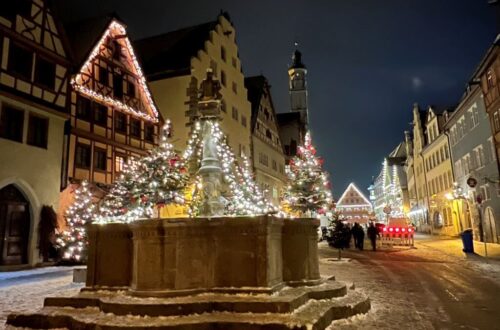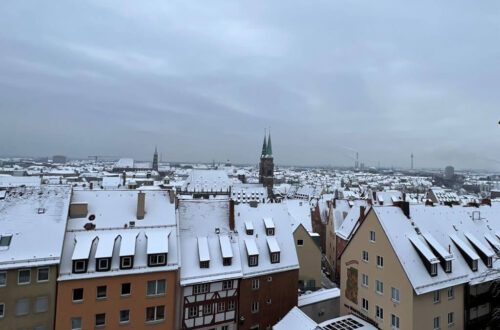A Day in the Fairy Tale Town of Rothenburg ob der Tauber
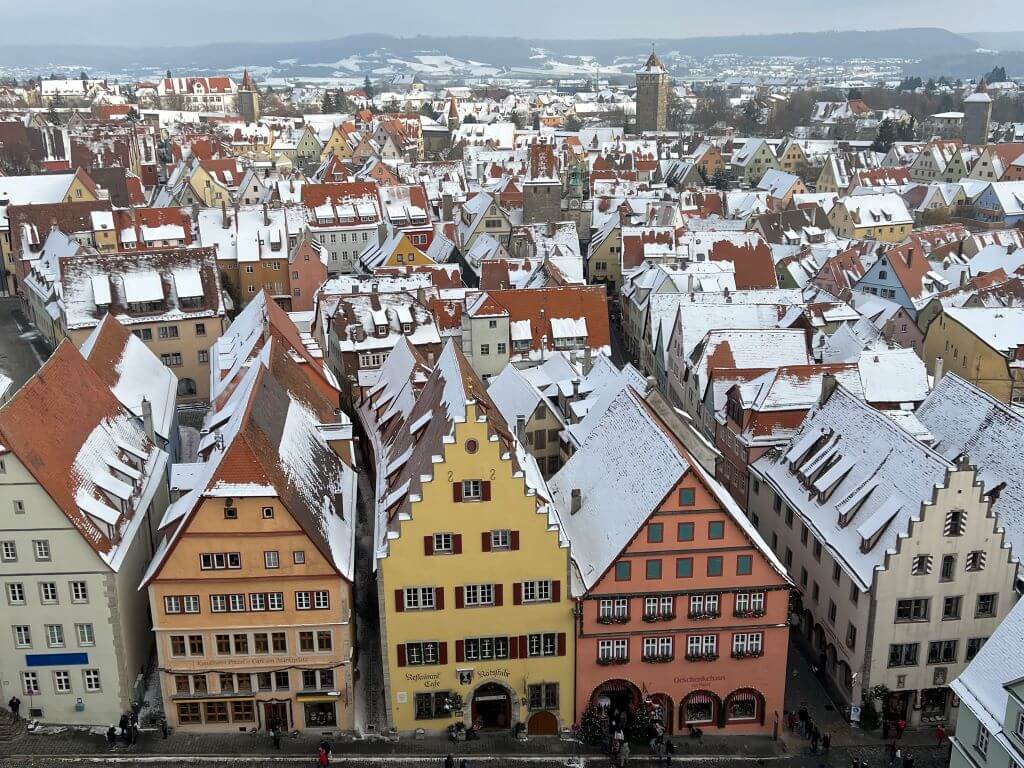
A visit to Rothenburg ob der Tauber seems to top many people’s travel bucket lists when coming to Germany’s Bavaria region. Indeed, 1.5 million people come to this otherwise sleepy medieval town every year according to its tourism board.
And it’s no wonder why. Rothenburg has a little bit of everything to satisfy almost any tourist’s needs. It has museums, history, shopping, great food and wine, outdoor escapes, and a delightful medieval ambiance sure to keep your eyes wide with wonder. Most importantly of all, Rothenburg is simply a stunning place to visit!
This guide shares my experiences here when we visited during the 2022 Christmas season. I was surprised to discover how much Rothenburg was able to pack into its small size. Like so many before me, it ended up being my favorite stop on our trip.
Disclaimer: This post may contain affiliate links. If you make a purchase through one of these links, I will earn a small commission. This occurs at no added cost to you.
Orientation to Rothenburg
The area around Rothenburg first became populated in the late 10th century, yet it wouldn’t be a major player in Germany for another 300 years when it received the status of a free imperial city of the Holy Roman Empire. This status gave Rothenburg essentially free rein to govern its own affairs. Around this time, Rothenburg also gained economic importance due to its access to plentiful resources.
Rothenburg’s good fortunes changed during the Thirty Years’ War. Roving armies occupied town and pillaged its resources during the course of the war. Then, a plague struck shortly after the war, further devastating the population.
These two events taken together caused Rothenburg to become frozen in time. With no resources or political clout, there was no more growth. It’s for this reason that Rothenburg is so well preserved today.
Rothenburg remained largely forgotten till the 19th century when Romantic painters began to visit and portray the town in their paintings. Some of these works can be seen in the town museum.
In World War II, the Nazi party looked at Rothenburg as the ideal image of a German community. Their soldiers eventually occupied town, which led to its bombing by Allied forces in 1945. A substantial portion of the eastern part of town was destroyed and then rebuilt in the postwar period.
Today, Rothenburg is popular with tourists eager to see what is regarded as one of Germany’s best-preserved medieval towns.
Be careful that you don’t visit the wrong Rothenburg! Germany has several other towns named Rothenburg. For simplicity’s sake, most people simply refer to it as Rothenburg, but its full name is actually Rothenburg ob der Tauber.
Town Wall and City Walk
Rothenburg’s main highlight is walking around its streets and admiring the overwhelming cuteness of its architecture. You can easily walk from one end of town to the other in a matter of minutes, making it exceedingly easy to see all the best spots in an hour without stops.
The main streets to focus on are Klostergasse, Herrngasse and Schmiedgasse (which turns into Spitalgasse). Fortunately, these three roads all radiate out from the towns adorable Market Square, so it’s almost impossible to get lost.
Most people’s favorite part of town is where Schmiedgasse turns into Spitalgasse. This is the highly Instagrammable Plönlein intersection, where two roads branch off from Schmiedgasse. One road turns left to become Spitalgasse, passing under a medieval guard tower, while the other plunges down to the right. Along the roads are multiple half-timbered houses. Even though this intersection has been photographed thousands of times, it’s still a gorgeous sight in person.
Nonetheless, it wasn’t my favorite part of walking through Rothenburg. That honor goes to the town wall. Walking up any one of the several staircases leading up to the wall feels like stepping back in time to the town’s imperial heyday.
The wall wraps almost two miles around town, providing for many great views. Along the way, you also pass through many of the original guard houses. It’s not hard to imagine a sentry walking the wall looking out for medieval threats. One word of advice: Bring a flashlight if it’s dark. The guard houses were completely pitch black when I visited in the early morning.
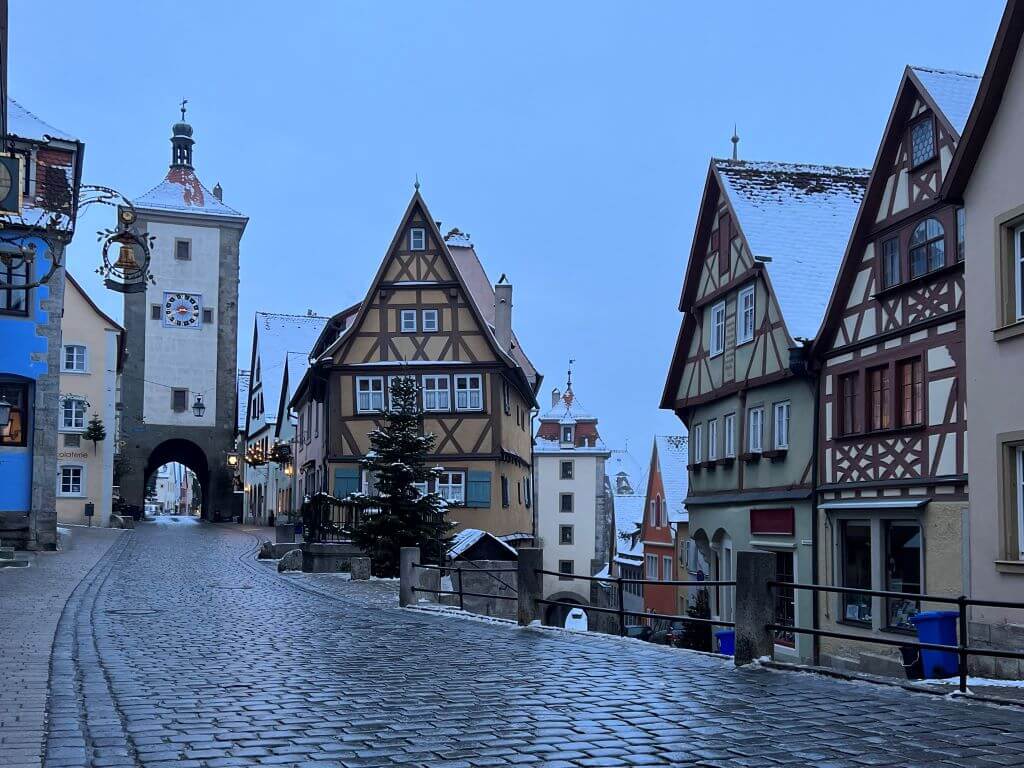
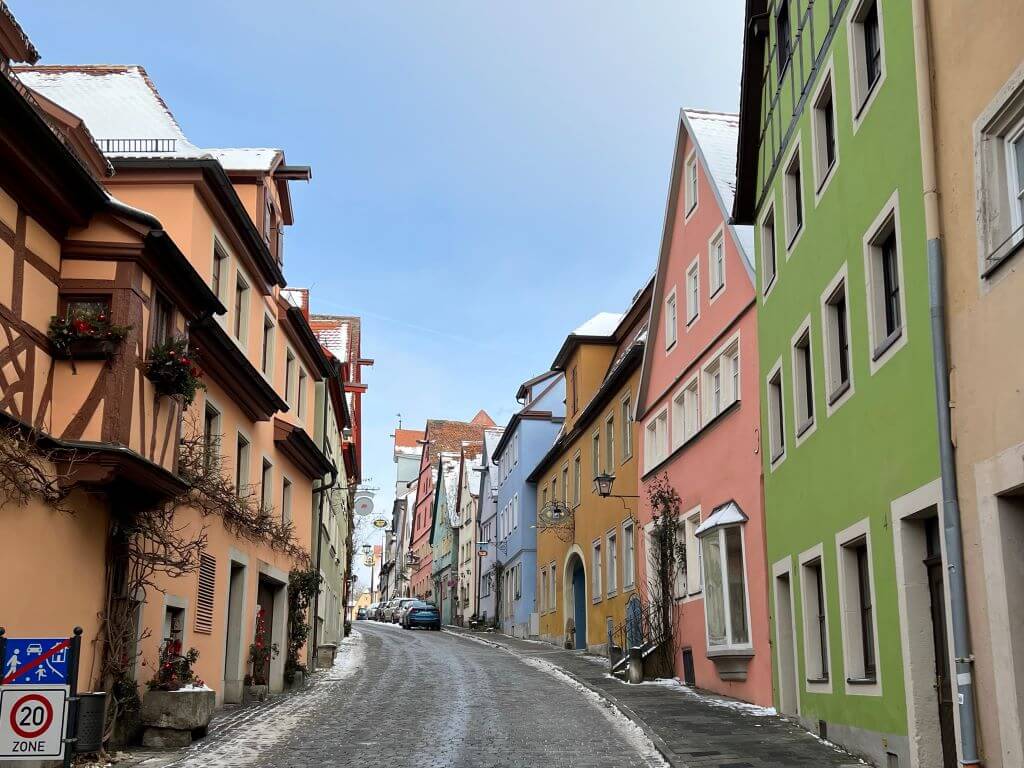
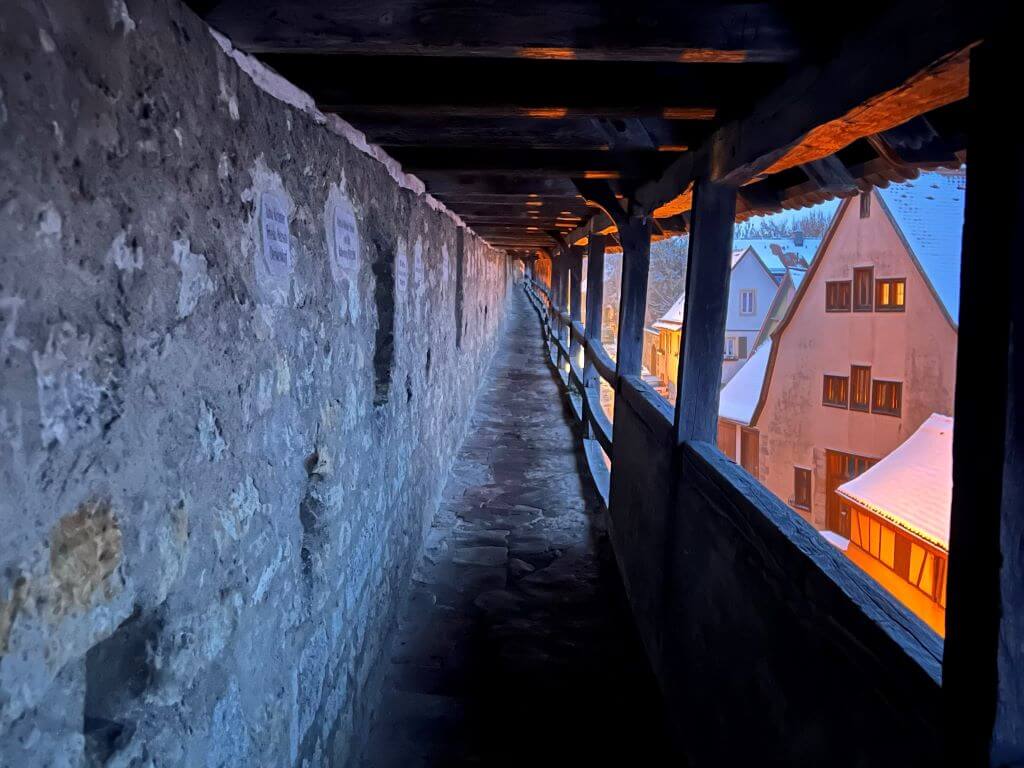
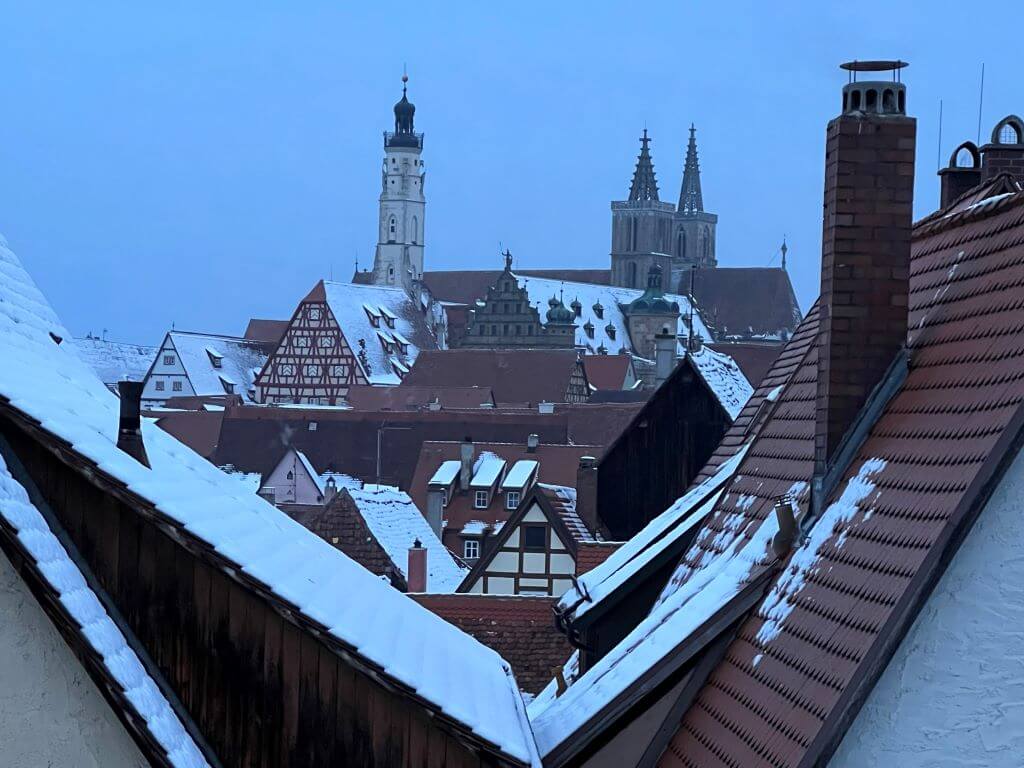
Photo Tip for Plönlein: I made the mistake of waiting till morning to take a photo here. I hoped to get a picture without tourists blocking the scene. Unfortunately, because we were there in December, the sky was gray and cloudy, resulting in somewhat gloomy photos. Just take your photo when you have good conditions regardless of crowds.
Castle Garden
| Hours | Always open |
| Length of Visit | At least 15 minutes |
| Cost | Free |
| Highlights | Views of Rothenburg, greenspace away from tourists |
Rothenburg’s Castle Garden protrudes from the western flank of town and offers fine views in a relaxing greenspace.
When we visited, the Castle Garden was a covered in a layer of snow, so I can’t speak to how it is in warmer months. Regardless of the time of year, though, make sure to visit here for great views of Rothenburg’s skyline along its southern wall.
The Castle Garden also holds a monument to one of Rothenburg’s darker moments. Beside the small chapel in the garden is a memorial to Jews who were burnt alive here in the Rintfleisch Pogrom of 1298.
Wondering where the castle is? It was destroyed in 1356 by an earthquake and its stones used to construct the town walls.
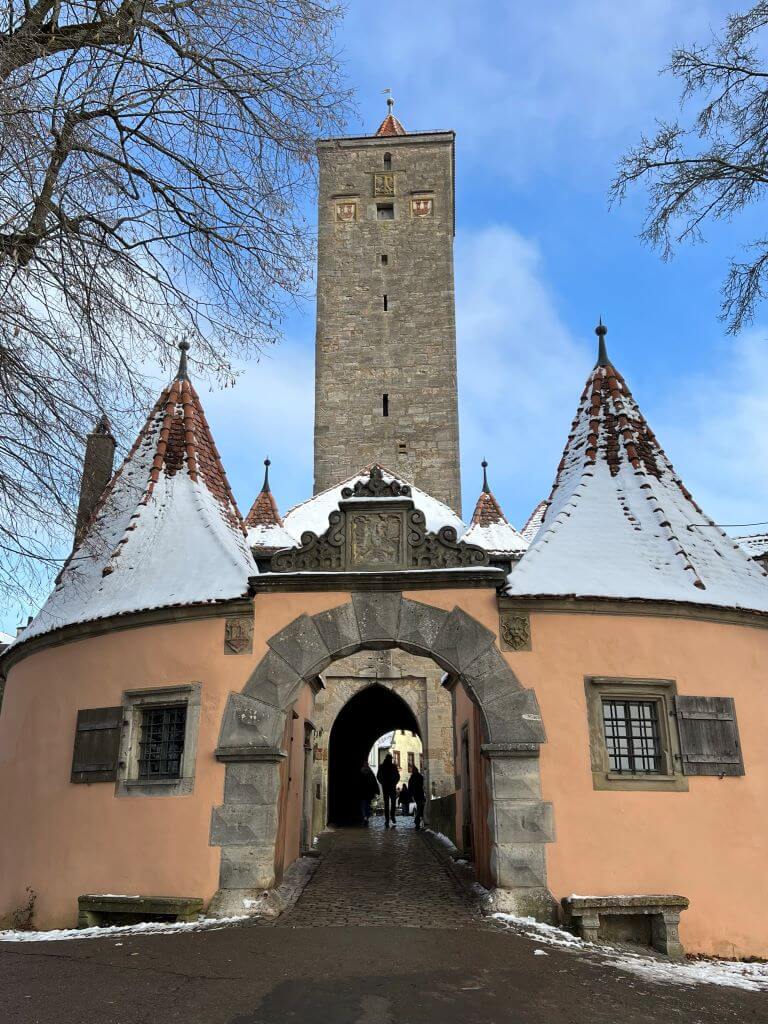
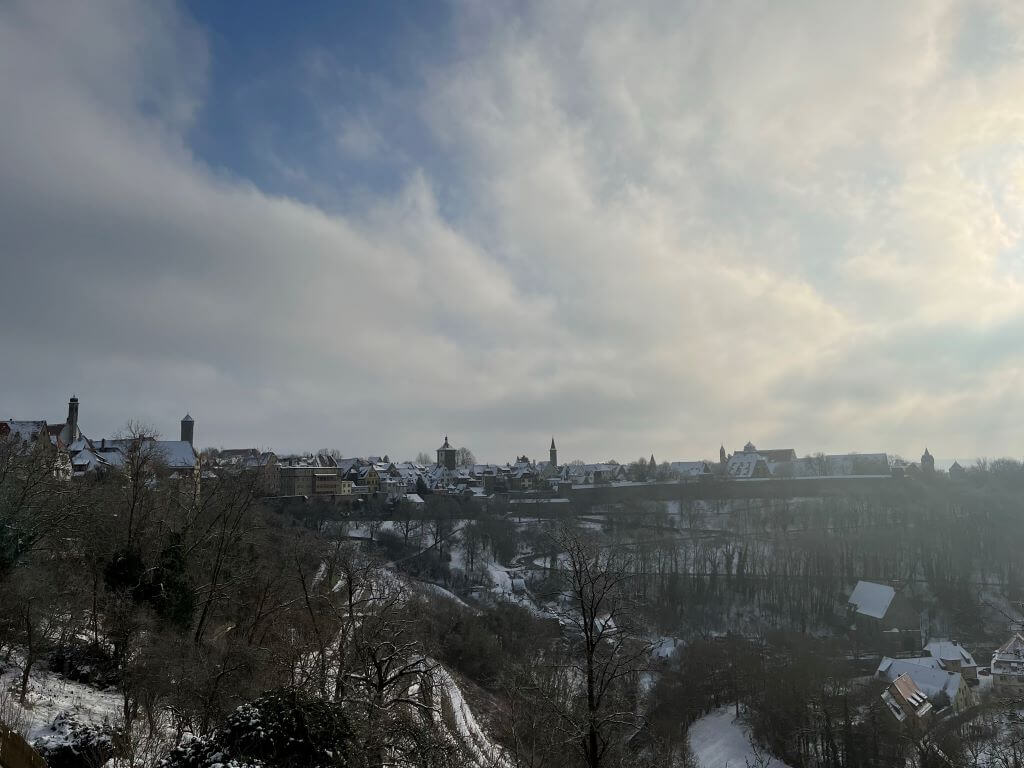
A few hours across the border is Hallstatt, another frozen-in-time town. Don’t miss a chance to visit if you’ll be heading to Austria!
St Jakob’s Church
| Hours | January – March Daily 12:00 – 5:00 April – October 30 Daily 10:00 – 6:00 October 31 – November 24 Daily 12:00 – 3:00 November 25 – December 31 Daily 10:00 – 5:00 |
| Length of Visit | 10 – 20 minutes |
| Cost | €3.50 |
| Highlights | Altar of the Holy Blood, Nave’s altar and stained-glass windows |
Dominating Rothenburg’s skyline is this large Lutheran church built from 1311 to 1484. It’s impossible to miss and warrants a quick visit for the exquisite altarpiece housed within.
Before walking in, take a few minutes to walk around the church’s south facade. Here, you can see a statue of St James (translated to St Jakob in German), an etched map of the city, and a hollow under the church with some timeworn statues. The statue of St James with his scallop, besides being the namesake of the church, marks Rothenburg as a stop on the famed Camino de Santiago pilgrimage route.
Inside, the nave is relatively simple owing to the church’s Lutheran legacy, but I rather enjoyed the contrast of the nave with the pretty altar and stained-glass windows at the end of the church. Nevertheless, the real highlight is up the stairs near the front of the church.
The Altar of the Holy Blood, carved by Tilman Riemenschneider in 1504, is a remarkable work of woodcarving. It shows the biblical scene of the Last Supper in stunning detail, from the hair of each man’s face to the twisting vines over their heads. At the top of the altarpiece is a crystal reliquary believed to hold a piece of cloth stained in the shape of a cross by communion wine, itself believed to be the blood of Christ.
A fact I found interesting about the altar is Judas can be removed from the carving. This would traditionally be done in the days leading up to Easter.
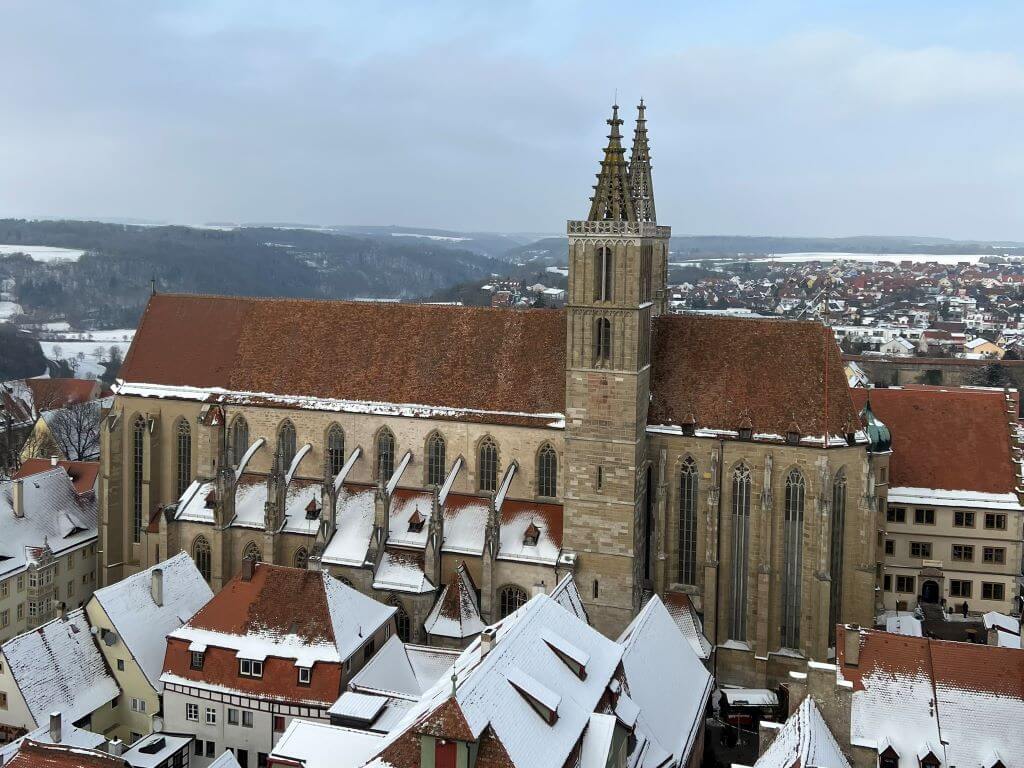
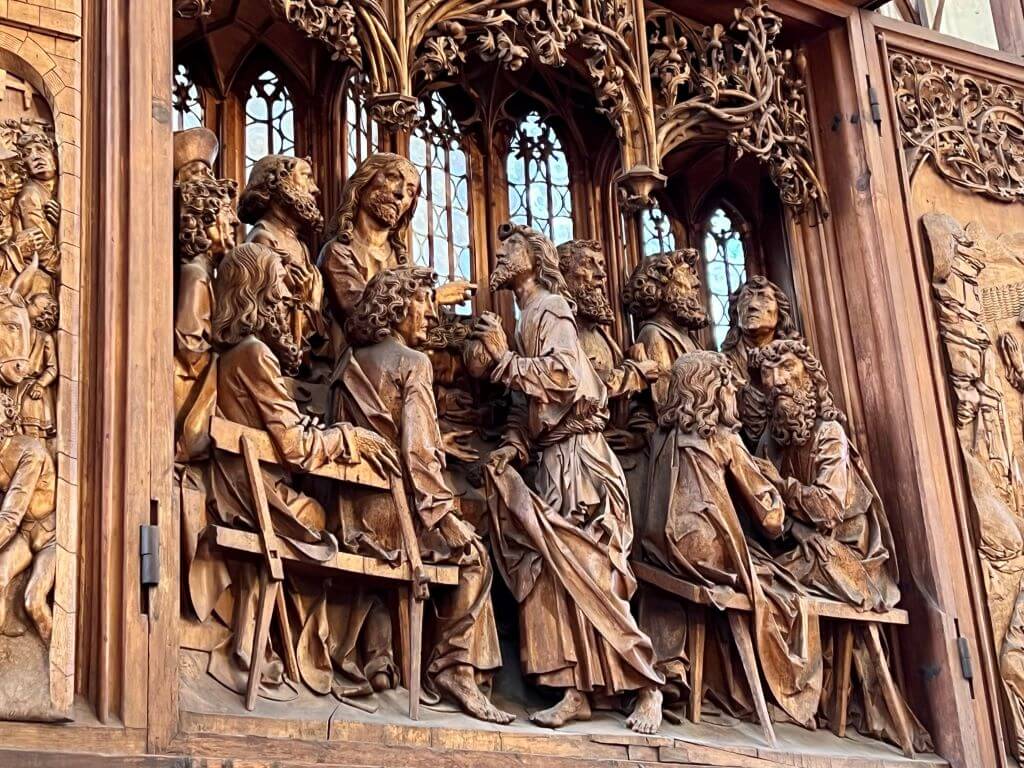
Town Hall Tower
| Hours | Daily 9:30 – 12:30, 1:00 – 5:00 |
| Length of Visit | 10 – 15 minutes |
| Cost | €2.50 |
| Highlights | Views of Rothenburg |
Rothenburg has a handful of good viewpoints, yet easily the best is from the top of the Town Hall tower. The tower has 214 steps to climb, and for the most part is relatively easy. It does get tight and extremely steep at the top, though. In fact, the last little bit is essentially a ladder.
Once you exit onto the tower’s viewing deck things get a little sketchy if you’re afraid of heights. It has a wrought iron fence to keep you from falling, but you’re otherwise exposed to the elements. When you’re standing there 200-feet high with the wind in your face, it can feel a little intimidating.
Still, it’s worth it for at least a peek at Rothenburg’s timbered rooftops and the surrounding Tauber Valley.
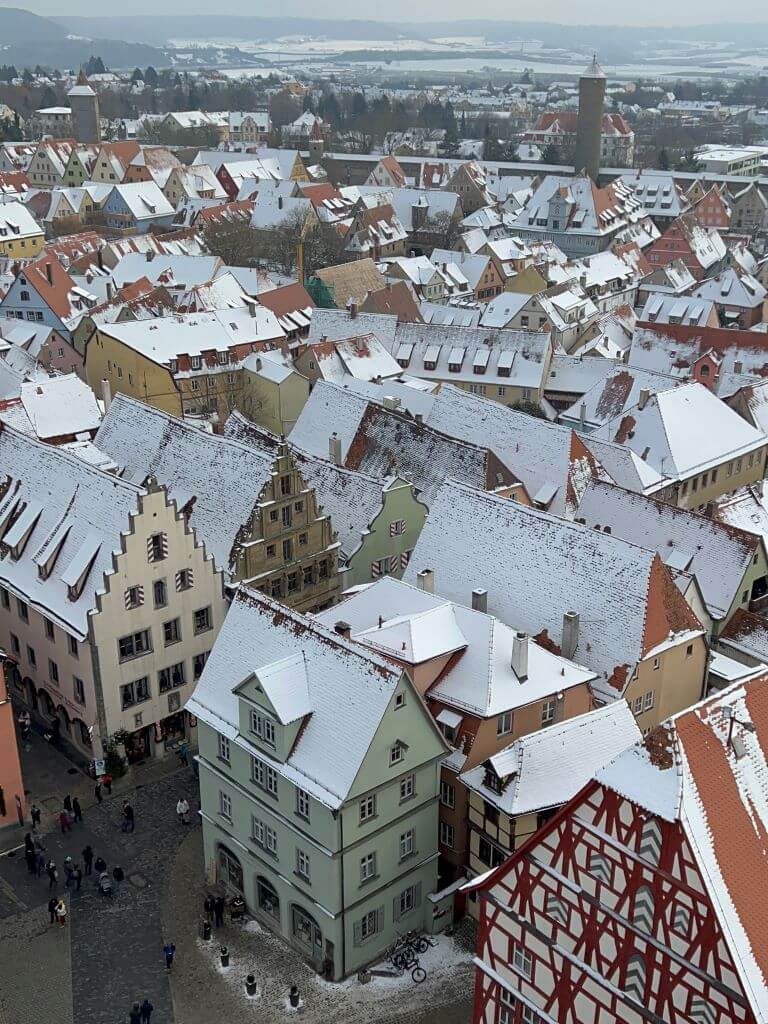
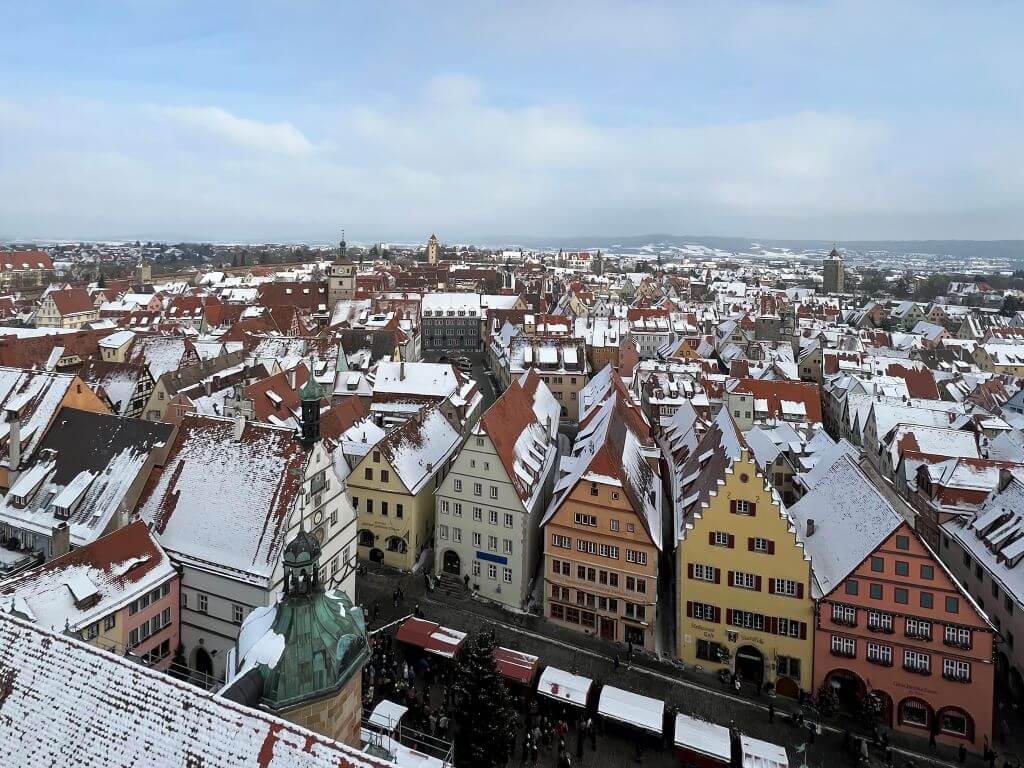
Rothenburg Museum
| Hours | April – October Daily 9:30 – 5:30 January – March, November – December Daily 1:00 – 4:00 |
| Length of Visit | 60 minutes |
| Cost | €5 |
| Highlights | Handcrafted shop signs, original town statues, Steins and tankards |
Rothenburg’s town museum is an excellent addition to any visit here. It’s located in a converted Dominican convent in a sleepy corner of town.
The museum contains a surprising number of smartly assembled displays and objects. Some of my favorites were the hallway containing original statues from around town and a room showing handcrafted store signs. We had fun trying to figure out what each store would have sold based on its sign.
Another highlight is the many steins and tankards on display. The level of artistic detail that went into the creation of some of these cups is fascinating. Don’t miss the legendary Meistertrunk! This particular tankard inspired the probably made-up story of Rothenburg’s mayor during the Thirty Years’ War. Supposedly, an opposing general said if he could drink 3 1/4 liters of wine from the cup in one swig, he would spare the city. In an act that sounds like it is straight from the movie Animal House, the mayor downed the wine, saved the city, and probably felt terrible the next day.
Getting around the museum is a breeze, as it’s assembled in a mostly circular route. There are a few areas where you can go into smaller side rooms, but it’s almost impossible to miss anything.
The primary exception to this is towards the end of the tour. In the hallway before you exit back to where you began, you can visit a few smaller, mostly skippable rooms off to the side. Of these rooms, the only one that bears visiting is the one describing the history of Jewish people who lived here.
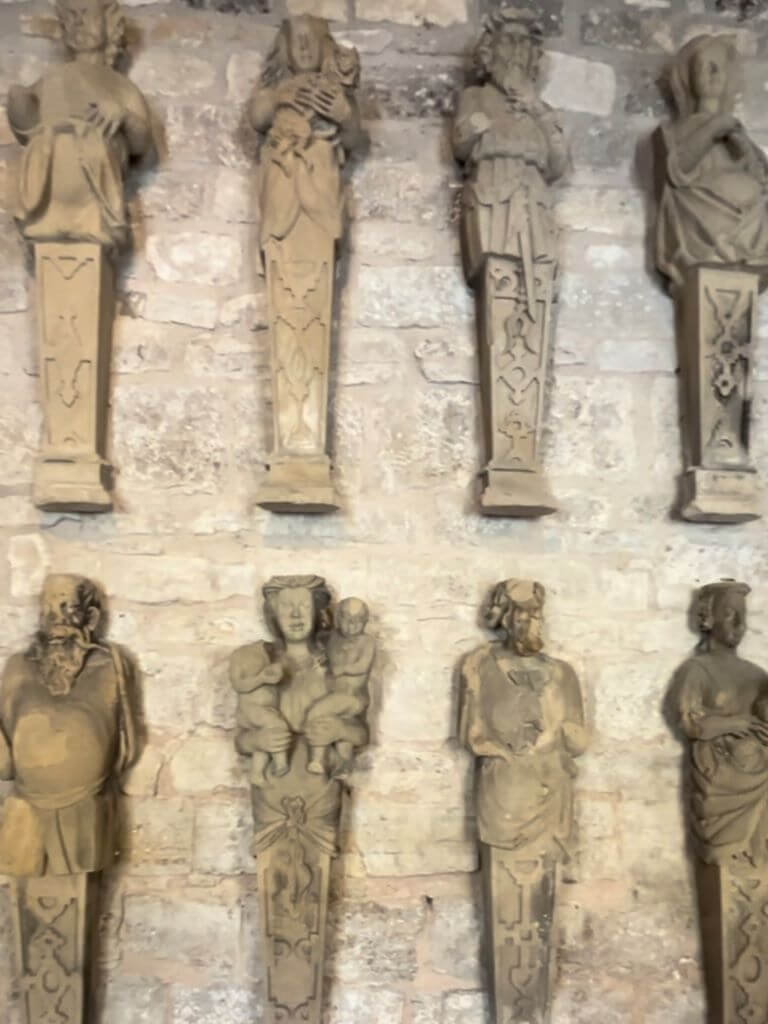
Medieval Crime Museum
| Hours | April – October Daily 10:00 – 6:00 November, January 9 – March Daily 1:00 – 4:00 December – January 8 Daily 11:00 – 5:00 |
| Length of Visit | 60 – 90 minutes |
| Cost | €9 |
| Highlights | Shame masks, original torture devices, Detailed history of law and order in the region |
Rothenburg’s Medieval Crime Museum feels a little misplaced considering the rest of Rothenburg’s enchanting ambiance. This museum contains many original macabre objects demonstrating how torture and humiliation played pivotal roles in medieval justice. However, it’s more than just the typical medieval torture museum found throughout Europe.
While it does have its fair share of devious contraptions on display, including bizarre shame masks and gruesome torture devices, it also tells the history of law and order in the region. It even delves into more superstitious parts of history like witchcraft and how it was punished.
I have two pieces of advice to help your visit here go smoothly.
First, the Medieval Crime Museum has a lot of royal and religious decrees. If you read one of them, you may as well have read them all. They’re interesting in that they’re original copies. Beyond that, though, the language they used was difficult to read for my modern eyes, and they didn’t add much to my understanding of the era.
Second, even the interesting descriptions sometimes repeat information from earlier displays. They can be pretty wordy, too. In a museum with a lot of displays and descriptions, they can cause some mental exhaustion. Save your energy for things you’re interested in rather than spend too much time early on reading everything (like I did).
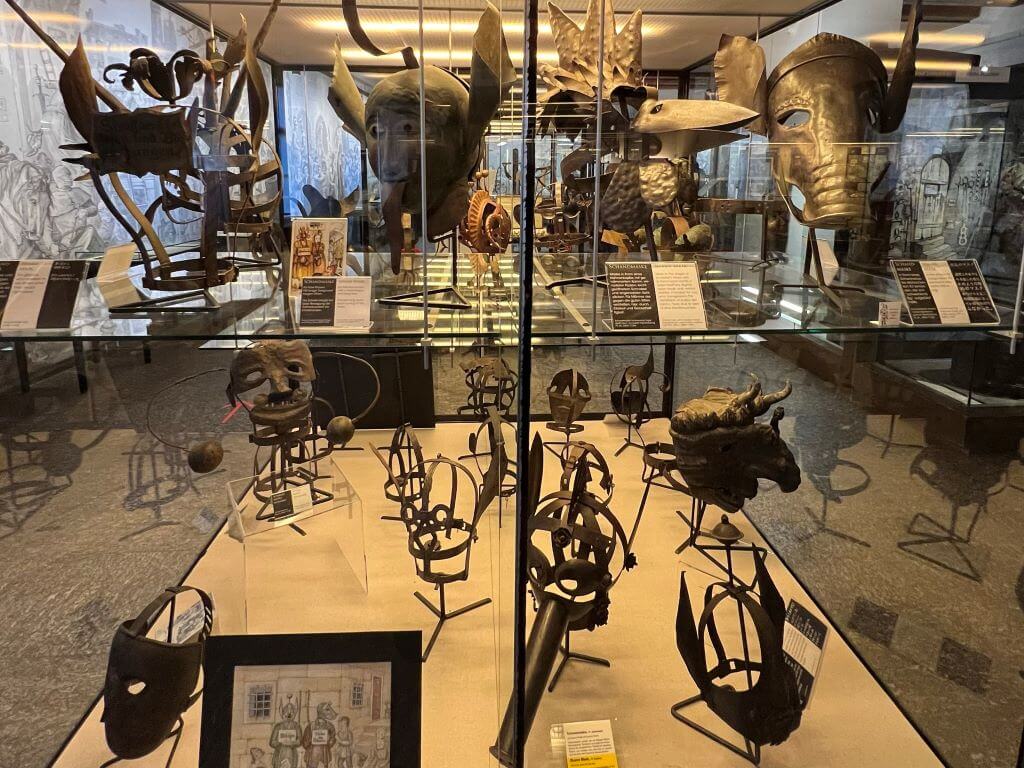
Be wary of visiting the Medieval Crime Museum and the Rothenburg Museum in the same day. It’s doable but can result in museum fatigue. Consider which one you think you’ll be more interested in, and plan to visit it first. My advice is to do the city museum and then the Medieval Crime Museum.
German Christmas Museum
| Hours | April – December 23 Daily 10:00 – 5:00 January 16 – March Monday – Saturday 11:00 – 4:00 |
| Length of Visit | 30 minutes |
| Cost | €5 |
| Highlights | Exhibits on Christmas smokers, trees sent to soldiers during WWI, Tree stands |
Upstairs from the Käthe Wohlfahrt store is a pleasant little museum that takes you through the history of German Christmas decorations. Even just four days before Christmas, we were one of only about 10 people in this museum. It’s a bit hidden up a nondescript staircase making for a relaxing getaway from the hustle and bustle of the store.
The exhibits are lovingly arranged and offer interesting looks into many holiday traditions. Detailed information cards accompany each display. These are very descriptive but maybe contain a bit too much information. You may want to only spend time reading those cards that particularly interest you to save some time.
Even if you skip the information cards, it’s enjoyable to just look at the old decorations and how they evolved over time. It’s bound to put you in the Christmas spirit whether it’s that time of year or not.
Käthe Wohlfahrt Store
After leaving the museum, you’re deposited in the Käthe Wohlfahrt store. However, if you aren’t visiting the museum, you may want to walk into the store anyways for some Christmas magic.
At Käthe Wohlfahrt’s, every day is Christmas whether you’re visiting around the holidays or not. Wohlfahrt’s doubles as a store for decorations and something like a year-long Christmas wonderland.
Even if you don’t plan on buying anything, it’s still fun to walk around to peruse what’s on sale and marvel at the different displays.
While it is a delightful shop, it understandably gets very busy – a bit chaotic, actually – around Christmas. It’s still worth checking out but having to shuffle through the store in a single-file line takes some of the magic away (and replaces it with crowd-induced anxiety).
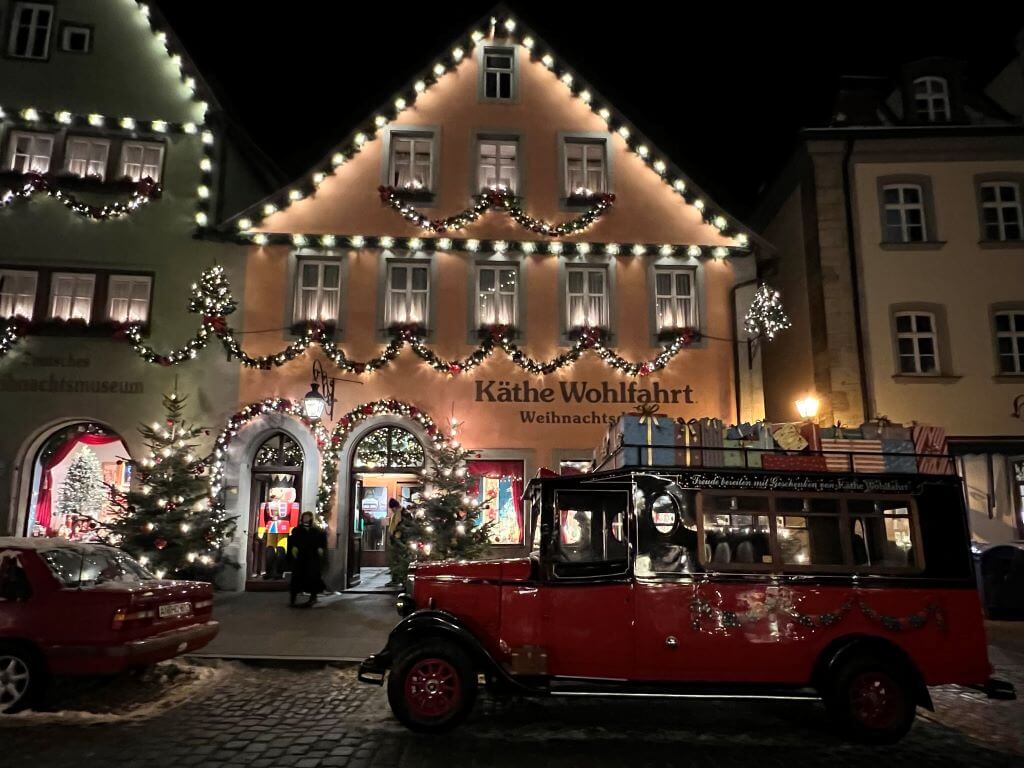
Visiting Rothenburg at Christmas
Rothenburg is home to one of Germany’s top-rated Christmas markets. Of the three main markets we visited (Munich and Nürnberg being the other two), Rothenburg was easily my favorite.
It’s smaller size and too-cute-for-words buildings are the perfect backdrop for drinking glühwein and perusing the many different market stalls. I also enjoyed Rothenburg’s market because it, like the town, was small and easy to navigate. It was just the right size to offer enough to keep me entertained without also overwhelming me, as was the case with Nürnberg’s market.
Besides the market, the rest of town is beautifully decked out with garland, twinkling lights and Christmas trees. Rothenburg already feels like it was pulled straight from the pages of a fairy tale. Visiting during Christmas only adds to the magic.
Practically, you can expect larger crowds if you visit Rothenburg on a Friday or Saturday, especially as Christmas draws closer. However, we visited on the Sunday before Christmas and crowds were very manageable.
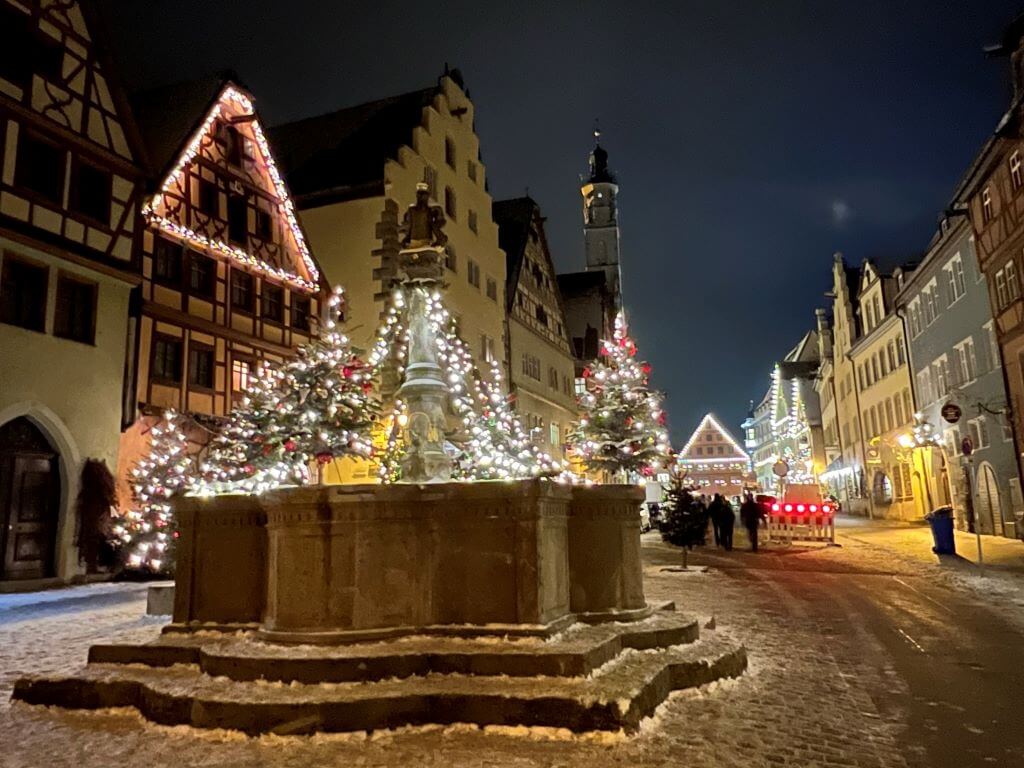

Don’t miss my post describing our experiences visiting some of Bavaria’s best Christmas markets!
Where to Stay in Rothenburg
We stayed in the loveliest little hobbit hole of a hotel imaginable. Hotel Altfränkische Weinstube perfectly encapsulates the look and feel of the rest of Rothenburg.
From the moment we first laid eyes on Altfränkische Weinstube’s exterior adorned with grapevines, we knew it was going to be special. Then, we walked in and were greeted by a reception area filled to the brim with knickknacks the owners have picked up over the years. It has a variety of stuffed animals, plants, wine bottles, and a myriad of other small decorations. Maybe it’s not always like this, but at Christmastime, almost every inch seemed to be adorned with something.
Our room at Altfränkische Weinstube was also a delight. It had finely carved wood dressers and dark timbered ceilings. These two features were exactly what I was hoping for in my stay here. Like the reception area, it was an ideal extension of the rest of Rothenburg’s fairy tale aesthetic.
Then, when you wake the next morning, the hotel includes a tasty breakfast of Bavarian pastries, fruit, eggs and cold cuts in a darkly lit room decorated much like the rest of the building.
Altfränkische Weinstube has no noteworthy negatives. If I had to nitpick, it has steep stairways and the ceilings in the room are a bit low. Still, I wouldn’t let either of those things keep you from booking a room here!
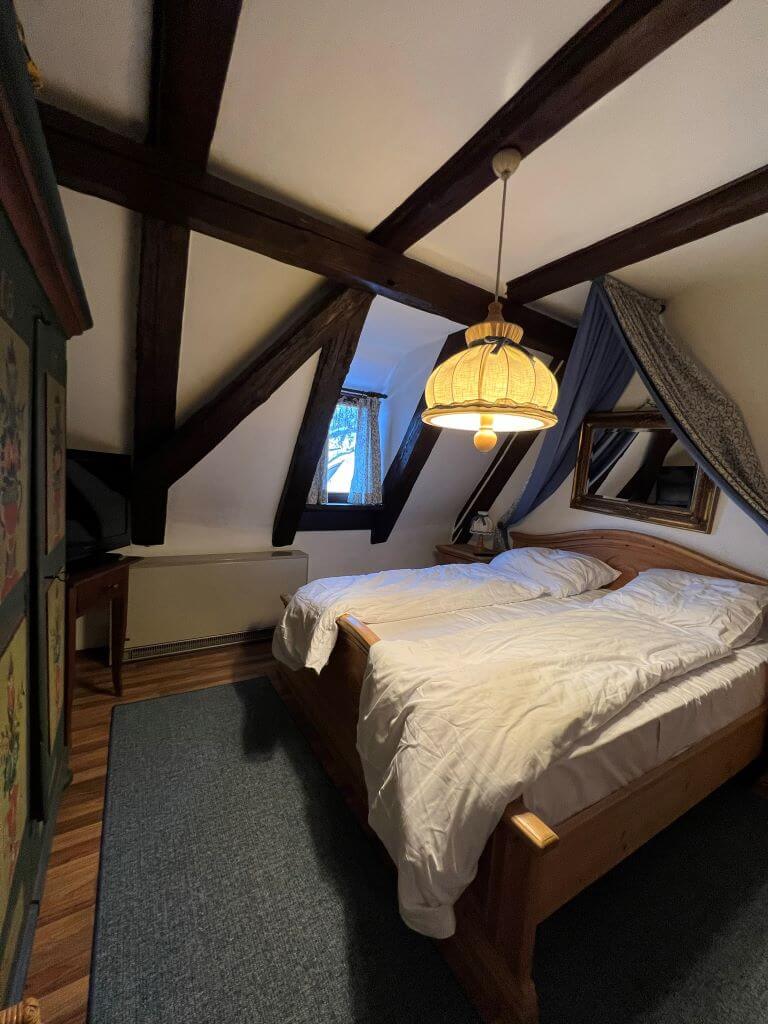
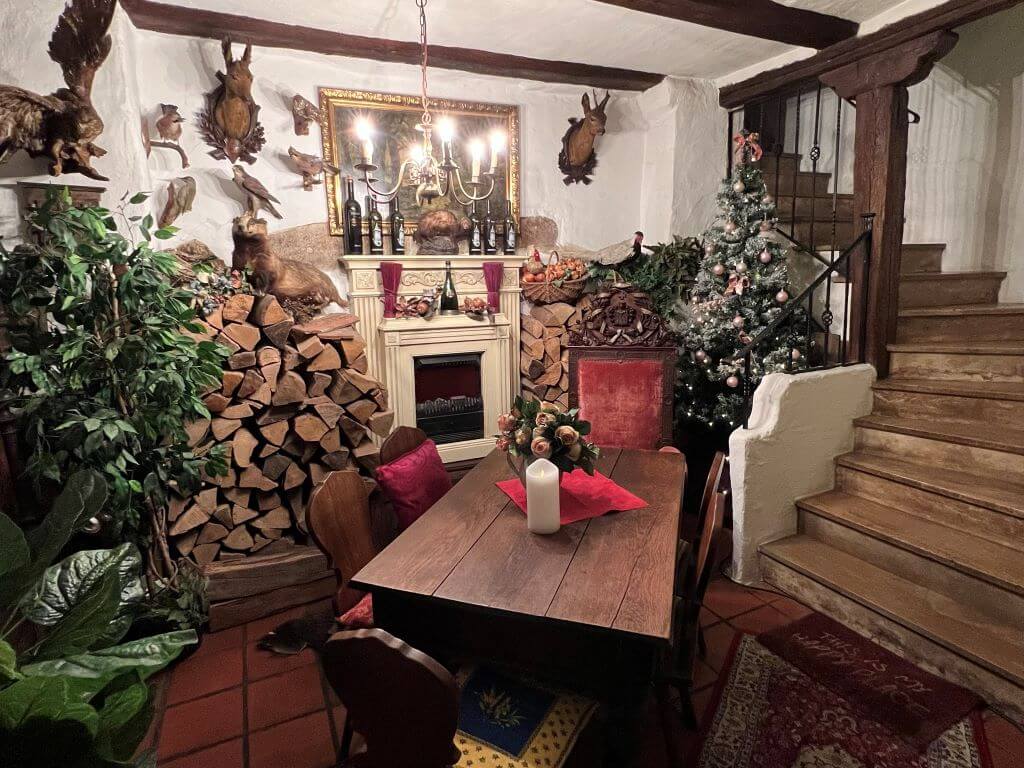
After Rothenburg, we headed farther south along the Romantic Road towards two of the best Bavarian castles in the region. Find out what it’s like to visit Neuschwanstein and Hohenschwangau!
Where to Eat and Drink in Rothenburg
Bräustüble
Bräustüble is a decent enough spot for a beer and to rest your legs after a busy morning exploring Rothenburg. We stopped here on a whim while strolling down the road connecting the market square and Plönlein.
They serve the typical beers you see throughout this part of Germany (chiefly Helles, Dunkel and a couple other varieties), as well as several flavors of schnapps. The inside is fairly standard fare, except it did stand out as one of the more traditional bar-looking places we saw during our trip.
Bräustüble also has a food menu if you’re looking for a bite to eat with your adult beverage of choice.
Zur Höll
Like many of the best drinking spots, Zur Höll is a cozy little spot found on one Rothenburg’s side streets. We went here because it is well known for its fine wine menu. The fact that it is regarded as the oldest home in Rothenburg was just a convenient coincidence.
After three days in Germany and lots of beer, Zur Höll was a nice change of pace. They have various varieties of Franconian wines from dry to sweet. Prior to my experience here, I mistakenly believed that all German wine was sweet. The two glasses of riesling I had here showed me otherwise.
Besides the wine and atmosphere, Zur Höll also has a small food menu to complement their drinks. Options range from smaller snacks to full meals. We had dinner reservations right after, so we shared a soup. I also took this opportunity to try schmaltz, a kind of condiment made from rendered animal fat. The soup was very good. The schmaltz was good to an extent. In small bites, I thought it was quite tasty. However, after so much of it, it started to make me feel a little queasy. I don’t think that’s any fault of Zur Höll’s, though; it’s just the nature of how it’s made.
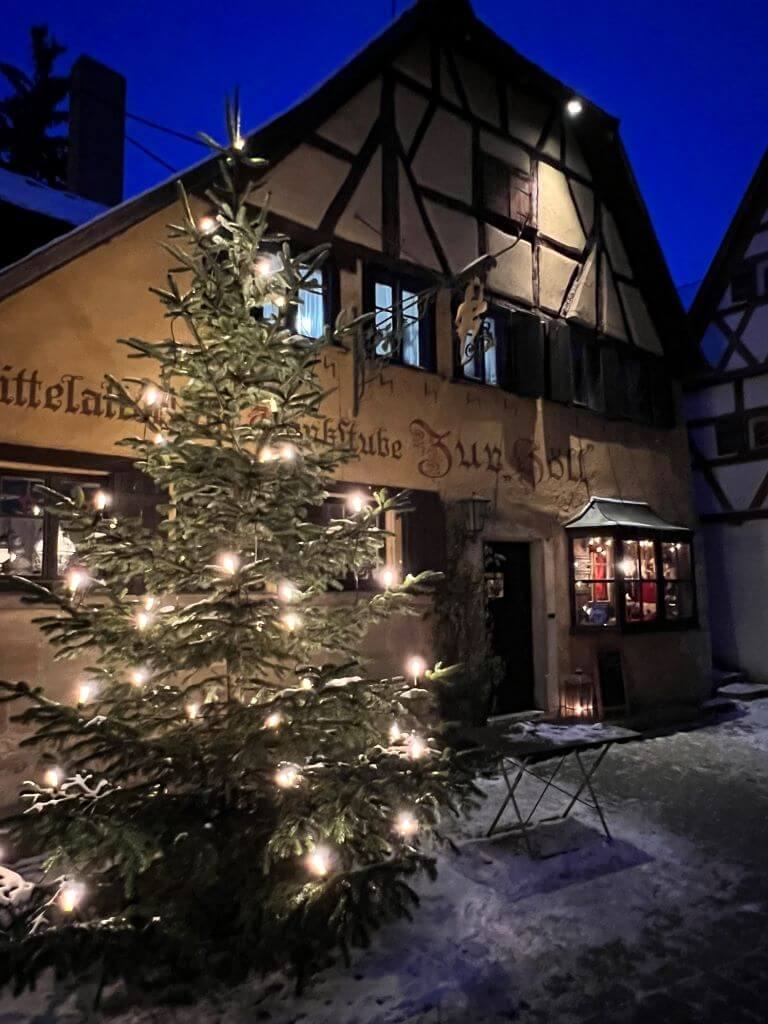
Zum Pulverer
Zum Pulverer is a restaurant and wine bar near Castle Garden. They serve traditional fare in a delightfully rustic setting. The hand-carved wooden furniture and interiors make for a perfect evening in Rothenburg.
One particularly fun detail can be found near the restaurants entrance. The tables here have chairs carved in the likenesses of some of Rothenburg’s past senators.
But a restaurant can only go so far with decoration alone if the food is no good, and Zum Pulverer doesn’t disappoint in this regard. Both our meals were delicious. I had the sausage platter: three types of sausage with a cold potato salad. It was one of the best potato salads I had in Germany, and the sausages were very tasty, too. Michelle had an incredibly tender pork steak with literal melt-in-your-mouth roasted potatoes.
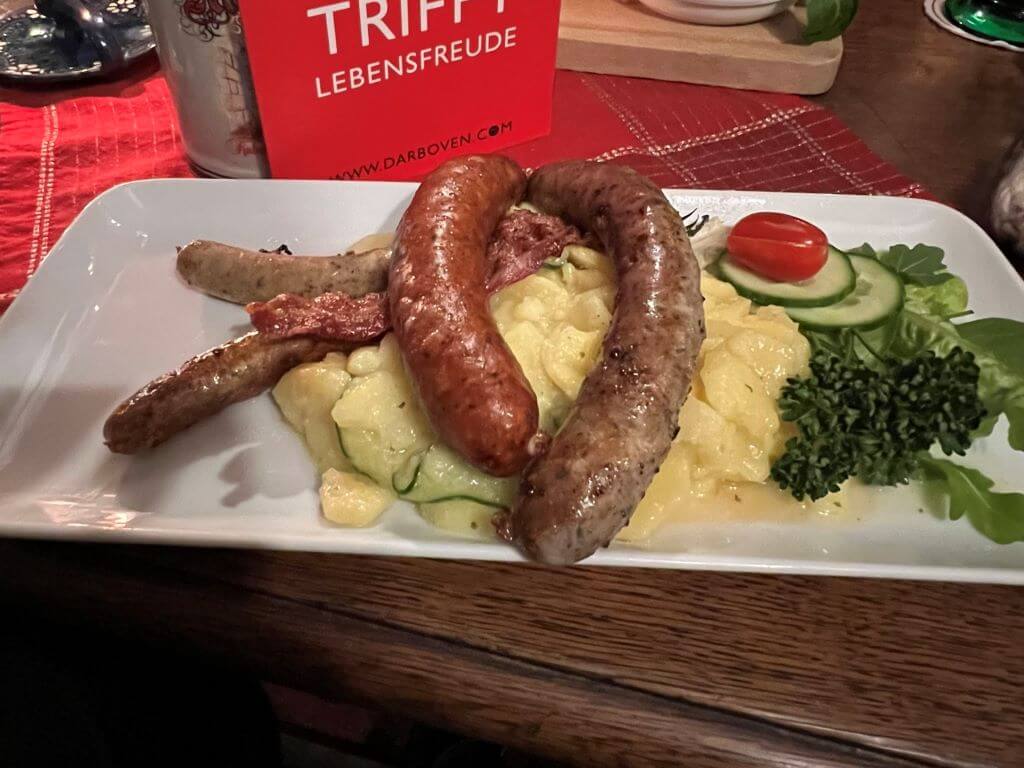
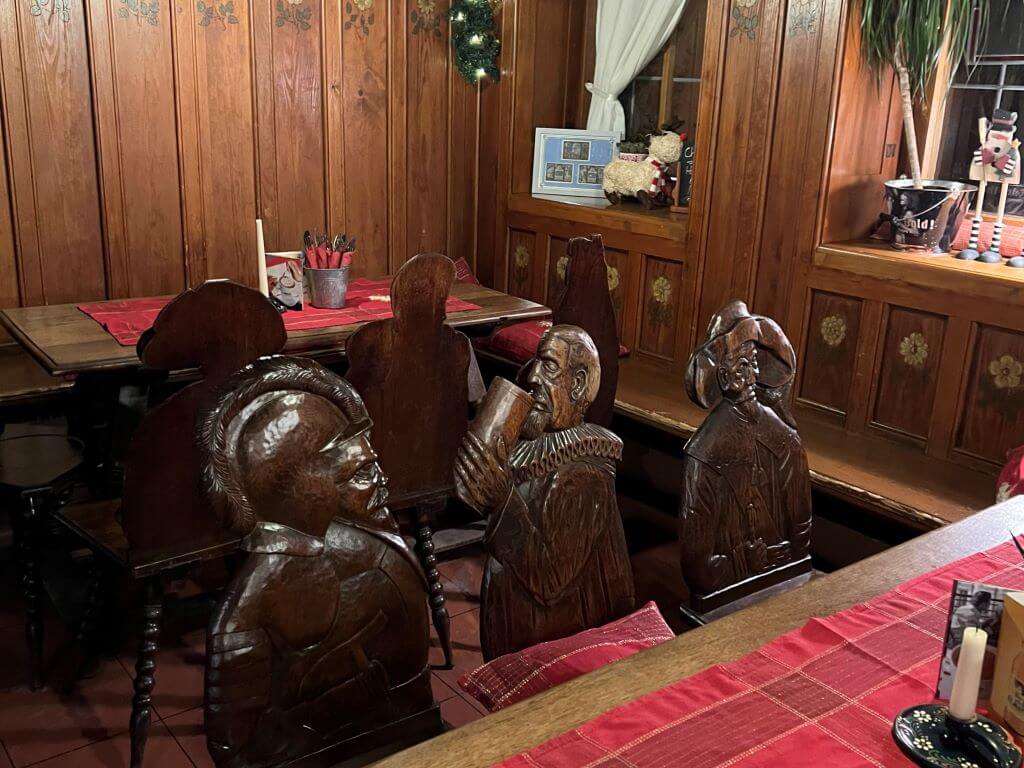
Frequently Asked Questions About Rothenburg
Can Rothenburg be done as a day trip?
Yes. In fact, Rothenburg is almost perfectly suited for a day trip from several nearby cities. The town’s small size makes it easy to see almost everything in several hours while still allowing for some time to rest your feet in between stops.
Should I do Rothenburg as a day trip?
It depends on the rest of your itinerary through Germany. If you have enough time, you should stay overnight in Rothenburg. The town is much more relaxing and enjoyable without the day trippers. It also gives you a chance to have dinner at one of Rothenburg’s quality restaurants.
On the other hand, if you don’t have time for an overnight visit, you definitely should visit as a day trip. As I covered above, it’s easy to do everything in a single day and well worth the effort and time to get here.
What else is there to do in Rothenburg?
The main thing people do in Rothenburg that I didn’t describe is the Night Watchman’s Tour. This tour is led by Hans Georg Baumgartner and takes visitors around town while telling tales of medieval life in Rothenburg.
Rothenburg also has a handful of walks that extend from the town’s wall out through the countryside.
How can I avoid crowds at Rothenburg?
The two easiest ways to avoid crowds are to either visit in the offseason or on a weekday when there will be less day trippers. Rothenburg’s off season lasts roughly from September to May.
Another option if you really want to avoid crowds is to skip Rothenburg altogether. The small town of Dinkelsbühl is about 45 minutes south of Rothenburg on the Romantic Road. It’s not as historically important as Rothenburg and lacks the number of tourist attractions, but it is almost just as cute. That said, I absolutely do not recommend skipping Rothenburg!
Resources to Book Your Trip to Rothenburg
Whether you’re looking for tours, hotels or flights, here are some tools to help get you started planning your trip to Rothenburg!
Look for activities and tours offered through GetYourGuide or Viator!
Search Flights
Still can’t find what you’re looking for? Check out my travel essentials pages for more of my recommendations.
Pin This Post!




